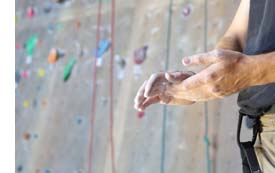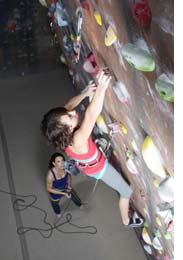Ascend to Fitness
- By Rebecca Taggart
- Reading Time: 3 mins.
Before the 1990s, rock climbers were relatively few and far between, either dedicated aficionados who lived near mountainous areas to pursue their passion or weekend warriors making long drives and taking a gamble on the weather. Twenty years later, the mountain has come to you, with specialized climbing gyms common even in smaller cities and accessible during the coldest snowstorm.
 Generally speaking, climbing gyms are large indoor spaces with specially constructed rock or wood walls and thick padded floors. Most welcome beginners, offering introductory classes and training. Classes for kids are also quite common. Gym climbing for fitness and cross-training has grown exponentially in popularity, offering an exciting addition to exercise alternatives. And rock climbing can be a great workout.
Generally speaking, climbing gyms are large indoor spaces with specially constructed rock or wood walls and thick padded floors. Most welcome beginners, offering introductory classes and training. Classes for kids are also quite common. Gym climbing for fitness and cross-training has grown exponentially in popularity, offering an exciting addition to exercise alternatives. And rock climbing can be a great workout.
For those who have never climbed, it’s easy to assume that strength is everything. Even if you could never complete one pull-up at the school gym, climbing may still be for you. It’s a sport that is more about balance than brute strength, and at least as much about leg strength as arm strength. Climbing offers full-body exercise, bringing flexibility, concentration, and adaptability along with a lean strength. It even burns the calories of a serious run, approximately 500–800 an hour, depending on the level of difficulty and the climber’s weight.
Climbing walls can be plenty high, up to 70 feet, giving the climber a good workout to the top. Any time you climb higher than is safe to fall, you need to be “on belay.” This means you’re attached to a rope via a harness around your hips and upper thighs, while your partner, the “belayer,” holds the other end of the rope through a belay device on his or her harness, which acts as a friction brake to keep the rope from slipping and takes up the slack as you climb. This ensures your safety, since you cannot fall more than the slack in the rope. The climber and belayer typically switch off, so both get a chance to climb.

Climbing gyms use top-roping, where the climber’s rope is anchored through a carabineer linked to a bolt at the top of the climb. The climber is tied to one end, and the belayer stays on the floor with the other end. To come down, the climber “walks” down the wall still attached to the rope with the descent controlled by the belayer. Once down, the partners can switch roles.
Walls have different climbing routes that are rated by difficulty, from 5.1, the easiest level, up to expert at 5.15. In addition, gyms frequently change up the hand and footholds on individual routes to keep them fresh to regular climbers.
Most gyms also offer “bouldering,” which you can do without a partner and sans rope and harness, so no need for a belaying class. Bouldering is generally defined as a short climb that will not cause serious injury if you fall. It can offer climbing challenges as difficult or more so than traditional climbs. Bouldering routes are also rated for difficulty.
Gym Climbing—what you need:
- Find a climbing gym near you—try an online search for “indoor rock climbing” or “climbing gym,” and you’ll find a list of locations in your area. Some gyms also offer other fitness amenities such as weight rooms and cardio machines or yoga classes. Call or check their websites to find out about hours, class schedules, belaying requirements, and any membership fees.
- Waiver—you can usually download one from the website to fill out beforehand to speed up your check-in when you get to the gym.
- Equipment and clothing—climbing shoes and harnesses can usually be rented at the gym and are sometimes included in the cost of a class. Wear socks and comfortable clothes that are easy to move in.
- Belaying partner—gyms generally require that you take their belaying class and pass their belaying test before you climb, even if you have previous experience. You may need to book this class in advance. If you don’t have a climbing partner, most gyms can help you pair up with one.
Rebecca Taggart is a San Francisco-based yoga instructor.


